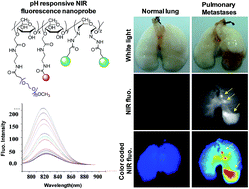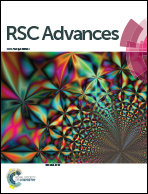pH-responsive near-infrared nanoprobe imaging metastases by sensing acidic microenvironment
Abstract
Metastasis leads to the vast majority of cancer deaths. To reduce metastasis-associated mortality, it is crucially important to detect metastases in their early developmental stages. Due to the small volume and diffused distribution of the metastases, an imaging probe to visualize the metastases with high target to background signal (T/B) ratio is a prerequisite. Acidification of extracellular pH (pHe) is a universal characteristic of solid tumors regardless of their genotypes and phenotypes. The acidic tumor microenvironment plays an important role in promoting dormant metastasis by driving protease-mediated digestion, disrupting cell–matrix interaction and increasing migration of cancer cells. Therefore, imaging tumor acidity holds the promise to visualize metastases with high sensitivity and universality. In this work, a pH responsive near-infrared (NIR) fluorescence nanoprobe NP2 was developed, in which multiple copies of NIR fluorophores were conjugated to dextran with acid liable hydrazone bonds. Under neutral pH, the signal of the fluorophores with spatial proximity is quenched efficiently via intramolecular electron transfer. However, the cleavage of acid liable bonds under physiologically acidic pHs with the concomitant diminishment of self-quenching effect leads to a remarkable signal enhancement. In vivo NIR fluorescence imaging indicated the remarkably enhanced NIR fluorescence in the chest of mouse models bearing pulmonary metastases after intravenous injection of NP2. Ex vivo fluorescence imaging demonstrated the capability of NP2 to visualize pulmonary metastases with volumes in the range of 0.5–28 mm3. Fluorescence microscopic imaging studies verified the high sensitivity and specificity of NP2 to detect metastases, which was further supported by histological H&E staining. Overall, the pH responsive nanoprobe NP2 showed feasibility to visualize metastases with high T/B ratios by sensing their acidic microenvironment.


 Please wait while we load your content...
Please wait while we load your content...